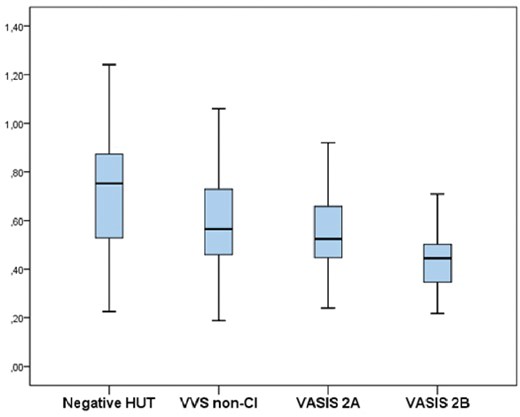-
PDF
- Split View
-
Views
-
Cite
Cite
V. Hamrefors, D. Nilsson, O. Melander, R. Sutton, A. Fedorowski, P1785
Low mid-regional pro-adrenomedullin predicts cardioinhibitory response during vasovagal reflex in adults above 40 years of age, EP Europace, Volume 19, Issue suppl_3, June 2017, Page iii394, https://doi.org/10.1093/ehjci/eux161.094Close - Share Icon Share
Funding Acknowledgements: The European Research Council (StG 282225), Swedish Medical Research Council, Swedish Heart and Lung Foundation,the Medical Faculty of Lund University
Background: The cardioinhibitory form of vasovagal syncope (VVS) may be responsive to pacemaker therapy in older adults. However, the neuroendocrine differences between cardioinhibitory (CI) and non-cardioinhibitory (non-CI) form of VVS are not completely understood.
Purpose: To analyze resting plasma-levels of four cardiovascular biomarkers in different types of VVS and negative head-up tilt test (HUT).
Methods: A total of 159 patients aged 40-89 years with unexplained syncope underwent head-up tilt testing (HUT) and blood samples were collected during supine rest prior to the test. Patients were classified as negative HUT, non-CI VVS, non-asystolic CI VVS, and asystolic VVS (VASIS 2B). Plasma-levels of C-terminal-pro-arginine-vasopressin (CT-proAVP), C-terminal-endothelin-1 (CT-proET-1), mid-regional-proadrenomedullin-peptide (MR-proADM), and pro-atrial-natriuretic-peptide (MR-proANP) were related to diagnosis.
Results: VVS was diagnosed in 110 patients (80 non-CI VVS, 11 non-asystolic CI VVS and 19 asystolic CI VVS). Forty-nine patients had negative HUT. Patients with asystolic VVS were younger (55±14) compared with negative HUT (67±14, p=0.002) and non-CI VVS (65±12, p=0.010). There was a significant and linear trend beginning with low plasma levels of MR-proADM in asystolic vasovagal reflex through higher values in non-cardioinhibitory reflex and highest levels in patients with negative HUT (Figure). Lower MR-proADM (Odds ratio [OR] per 1 Standard Deviation [SD]: 2.40, 95%CI, 1.22-4.71; p=0.011) and lower CT-pro-ET1 (OR per 1 SD: 1.66, 95%CI, 1.02-2.71; p=0.041) were associated with higher probability of asystolic VVS. Patients aged ≤ 65 years (median) with a plasma level of MR-pro-ADM of less than 0.46 pm/l (first quartile) had an OR of 8.8 (95 % CI, 2.5– 30.8; p=0.001) of asystolic VVS compared with older patients with higher MR-proADM-levels (Table).
Conclusion: In patients aged 40 years or more with unexplained syncope, lower age and MR-proADM are associated with asystolic VVS during HUT.

Abstract P1785 Figure. Levels of MR-proADM (pm/L)



